and historical purposes, all rights reserved.
This page is copyright© by
This page may not be sold or distributed without
the expressed permission of the producer
This camera manual library is for reference
and historical purposes, all rights reserved.
This page is copyright© by ![]() ,
M. Butkus, N.J.
,
M. Butkus, N.J.
This page may not be sold or distributed without
the expressed permission of the producer
If you find this manual useful,
how about a donation of
$3 to:
M. Butkus, 29 Lake Ave.,
High Bridge, NJ 08829-1701
and send your e-mail
address
so I can thank you.
Most other places would charge
you $7.50 for
a electronic copy
or $18.00 for a hard to read Xerox copy.
If you use Pay Pal, use the link below.
Use the above address for a check, M.O. or cash.
BACK TO MAIN CAMERA MANUAL PAGE
Click here to continue
to Chinon CP-X PDF version made from this file

INTRODUCTION
Welcome to the exciting world of CHINON photography! You have just purchased a fine camera that will give you many years of picture-taking pleasure. Your CHINON CP-X PROGRAM camera is one of the most sophisticated 35 mm SLR cameras available today. The CP-X PROGRAM incorporates programmed AE (Automatic Exposure), aperture priority kA, manual control, and auto film speed setting system. Please read this instruction booklet carefully and thoroughly familiarize yourself with the equipment and its features.
TABLE OF CONTENTS
|
Specifications Shoulder strap instructions Lens mounting Battery Installation Battery testing Film loading Frame counter Film advancement Film speed setting Focusing Viewfinder information Programmed AE (Auto Exposure) mode ("P" mode) |
Aperture Priority AE (Auto Exposure) photography Manual photography Shutter release and release lock Unloading exposed film AE lock system Self-timer Flash photography "B" Bulb setting Depth of field Auto winder system Infrared photography Optional accessories Care of the camera |
NOMENCLATURE
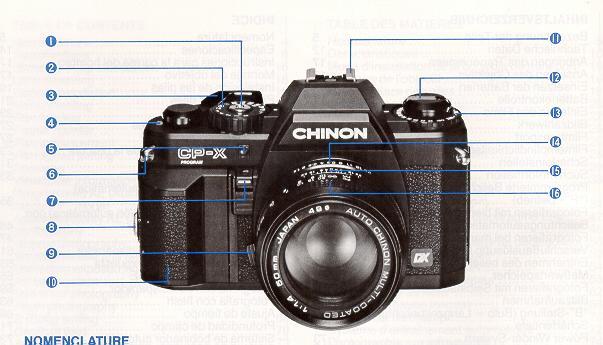 |
|
1. Shutter release button 2. Exposure mode select dial/ shutter speed dial 3. Film advance lever 4. Film counter window |
5. Self-timer LED 6. Shoulder strap eyelet 7. Self-timer/AE lock switch 8. Power grip attachment screw |
|
9. Lens lock release lever 10. Power grip (battery compartment) 11. Accessory shoe (hot shoe) 12. Film rewind knob and back opening knob 13. Film speed dial (ISO) 14. Aperture ring |
15. Depth of field scale 16. Focusing ring 17. Viewfinder eyepiece 18. Metal focal plane shutter 19. Film chamber 20. DX film contacts
|
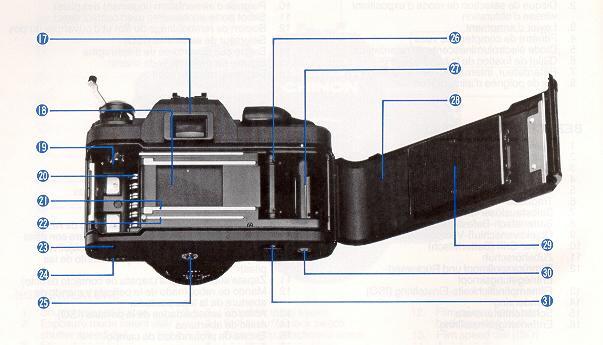 |
|
21. Film rail 22. Film guide rail 23. Power source contact 24. Power winder electronic contacts 25. Tripod socket 26. Sprocket teeth |
27. Take-up spool 28. Camera back 29. Film pressure plate 30. Power winder coupler 31. Rewind button |
SPECIFICATIONS
Type: 35 mm automatic compact SLR camera with TTL full
aperture programmed AE (instant stop-down
re-metering), Aperture priority kA, manual exposure system, and auto film speed setting.
Picture Format: 24 x 36 mm.
Lens Mount: CHINON universal bayonet mount ("K" type mount).
Mirror: Quick return mirror.
Shutter: Electromagnetically controlled focal plane
shutter, stepless speeds from 1 sec. to 1/1000 sec.
on automatic, maximum operation time at AE (A or P mode) is 8 seconds, 11 speeds from 1 to 1/1000 sec.
on manual exposure. Electronically controlled automatic and manual exposure.
Shutter Release: Electromagnetic type shutter release with safety lock and provision for cable release.
Viewfinder: Fixed eye level pentaprism central split image with micro prism collar, 7 LED's indicate over/
under and proper exposure, flash ready, program kA, aperture priority kA, and manual exposure mode.
Slow shutter speed warning by blinking "OK" LED in viewfinder when the shutter speed is slower
than 1/30 sec.
Viewfinder magnification: 0.87X (@50 mm, at infinity)
Viewfinder visibility: 92%
Exposure Meter: TTL center weighted full aperture system employing silicon blue cell.
Exposure Range: EV+ 1 (F1.4,1 sec.) to EV+ 19
(F22,1/1000 sec.) @ ISO 100, F1.4/50 mm lens.
AE Lock: Built-in exposure memory lock system.
ISO Range: 25-5000 for DX-coded film with 1/3 EV segment.
25-3200 for non-DX film with 1 /3 EV segment.
Film Advance: Single stroke in an arc of 130° with 25° stand off. Motorized film advance with optional
power winder.
Film Loading: Multi-slot take-up spool type.
Film Rewind: By depressing the rewind button and cranking the rewind lever.
Film Counter: Automatically indicates number of exposure and resets to "S" when the camera back is opened.
Self timer: Electronically controlled at 10 sec. with flashing red LED.
Accessory Shoe: Hot
Shoe type with "X" sync and a contact for CHINON dedicated flash.
"X" Synchronization: "X" flash sync at 1/100 sec. with dedicated flash (1/60 sec. with non-dedicated flash).
Slow Synchronization: 1/60 sec. or slower at manual.
Power Source: Four 1.5 alkaline (LR44) or silver oxide (SR44, G13) batteries, or two 3 V lithium batteries (CR-1/3N). Power Hold System: 12 sec. in manual exposure mode.
Battery Check: Built-in with LED indicator.
Accessories: CHINON power winders, Dedicated flashes, Info Back-2 data imprinting unit, Auto Date data imprinting unit, Super multi-coated lenses, Deluxe carrying cases and many more.
Dimensions: 136(W) x 88(H) x 51(D) mm (5.35" x 3.46" x 2.01") Weight: 498 9 (17.57 oz)
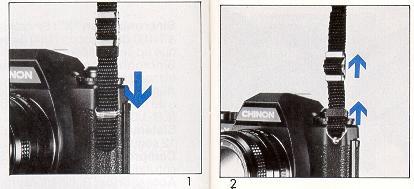
SHOULDER STRAP INSTRUCTIONS
Place the end of the shoulder strap through the retaining ring connected to the camera body lug. Fold the shoulder strap over the retaining ring. Place the end of the strap through the plastic retainer. Pull tight to secure. Thread the end of the strap through the metal buckle and pull tight to secure. Follow the same procedure on the other side of the camera (Fig. 1, 2).
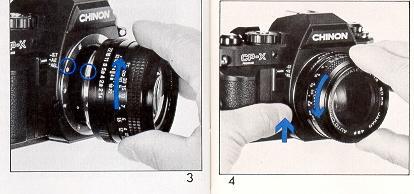
LENS MOUNTING
Your CHINON CP-X program is equipped with a CHINON "K" bayonet mount which accepts all interchangeable lenses with the "K" bayonet mount. To attach the lens, match the red dot on the camera body with the red dot on the lens (Fig. 3). Then insert the lens into the camera body and turn it clockwise until the lens locks with a click. To remove the lens from the camera body, depress the lens lock release lever, turn the lens counter clockwise as far as it will go, and lift it up from the body (Fig. 4).
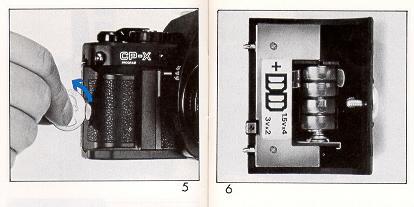
[Mike: note the 4 smaller batteries, 2 CR-1/3N can be used.
BATTERY INSTALLATION
2. Place four 1.5 V alkaline batteries (LR44) or silver oxide batteries (SR44, G13), or two lithium batteries (CR-1/3N) as illustrated inside battery compartment. (Fig. 6)
3. Attach the power grip to the camera body by turning the screw clockwise to secure it.
2. If you do not use your camera for a long period of time, remove the batteries, and store in a dry location. This will prevent the possibility of battery leakage and damage to your camera.
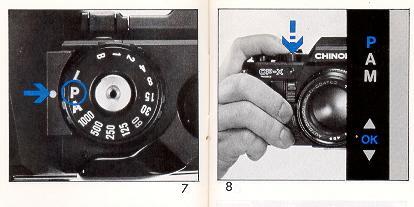
2. Look through
the viewfinder and depress the shutter release button halfway down to
confirm at least one of LED indicators in the viewfinder illuminates (Fig. 8).
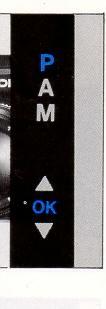
3. When nothing illuminates, replace the batteries with a fresh set or check to ensure the batteries are correctly installed.
FILM LOADING
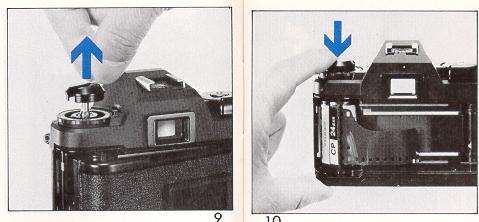
Pull up on the Film Rewind Knob until the Back Cover pops open (Fig. 9). Then
insert the film cartridge into the Film Chamber with the protruding end of the
cartridge positioned to the bottom of the camera. Push down the Film Rewind
Knob and slightly turn the knob in either direction until it "seats" properly
into the film cartridge spool (Fig. 10). Insert the trimmed end of the film
into one of the slits on the Film Take-up Spool (Fig. 11).
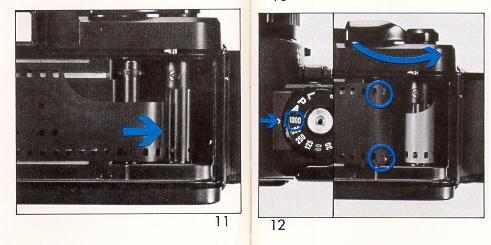
Turn the Exposure Mode Select Dial to "1000" setting and advance the film
while holding the film lightly down on to the transport sprockets. Release the
shutter if necessary and advance the film until the sprockets engage with the
upper and lower perforations of the film (Fig. 12).
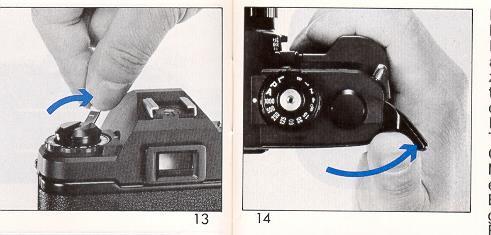
Then close the camera back firmly until it locks with a click. Now turn the film rewind knob
gently until all the slack is taken up and the rewind knob stops. Do not force
or further rewind the film (Fig. 13). Advance the film and release the shutter
three times (Fig. 14). The rewind knob should rotate counter clockwise as the
film is advanced and the "1 " marking should appear in the frame counter
window (Fig. 15).
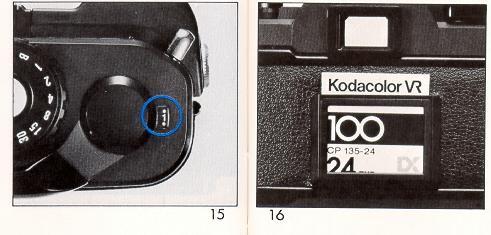
Turn the Exposure Mode Select Dial to the desired position. A convenient memo
holder is provided on the back of your camera. Whenever you load the film,
just cut off the top of the film box and put in the memo holder as a reminder
(Fig. 16).
FRAME COUNTER
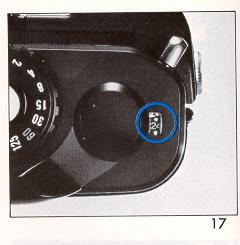
Your CHINON CP-X program is equipped with a frame counter which displays the
number of exposures made and resets automatically upon opening the camera
back. At the very beginning, the counter shows "S" indicating the start of the
picture taking process. When a film is loaded according to the procedure
previously described, the counter displays "1 " indicating that the camera is
ready for the first exposure. Every time the film advance lever is fumed the
counter will proceed one stop forward. The number 24 and 36 are colored in
orange to warn the end of commonly available films (Fig. 17).
FILM ADVANCEMENT
When the film end is reached, the film advance lever may stop before the lever is fully turned. Do not force the lever. Stop winding at once and rewind the film. Refer to "UNLOADING EXPOSED FILM."
FILM SPEED SETTING
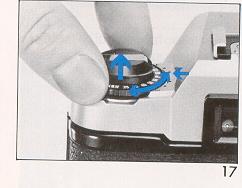
FOCUSING
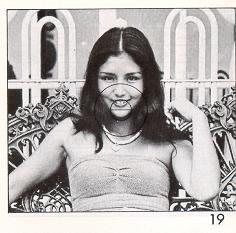
At the center of the viewfinder is the split image with microprism collar
which is then surrounded by ground glass. When the camera is in focus the
image on these focusing aids becomes sharpest. While observing the subject
through the viewfinder turn the lens focus ring until the upper and lower
split images match up to form a uniform image (Fig. 19). This split image
focusing is particularly helpful when the subject is dominated by vertical
lines.
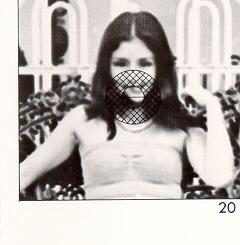
The microprism is also very helpful, when out of focus; the image on the
microprism will appear to shimmer (Fig. 20). When the focus is properly set,
the subject image will be sharply defined in the viewfinder. You can double
check the focus setting by the image on the ground glass. You can also focus
indirectly.
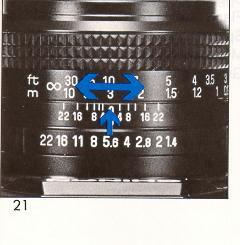
Actually measure or estimate the distance to the subject
and set the lens focus ring to the appropriate setting (Fig. 21).
VIEWFINDER INFORMATION
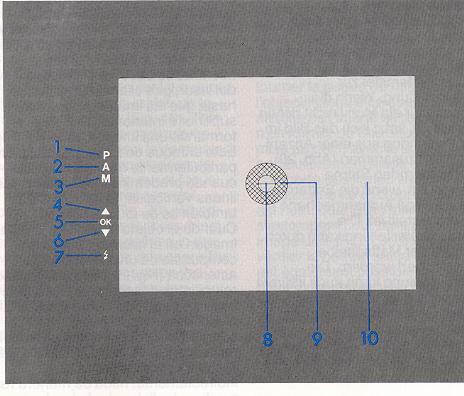
2. Aperture priority AE indication LED (red) 3. Manual exposure indication LED (red) 4. Over exposure LED (red) 5. Correct exposure indication LED (green) 6. Under exposure LED (red) 7. Flash ready LED (red) 8. Split image 9. Microprism collar 10. Ground glass Programmed AE (Auto Exposure) mode ("P" mode) Aperture Priority AE (Auto Exposure) photography |
Manual photography Shutter release and release lock Unloading exposed film AE lock system Self-timer Flash photography "B" Bulb setting Depth of field Auto winder system Infrared photography Optional accessories Care of the camera |
PROGRAMMED AE (AUTO EXPOSURE) MODE ("P" MODE)
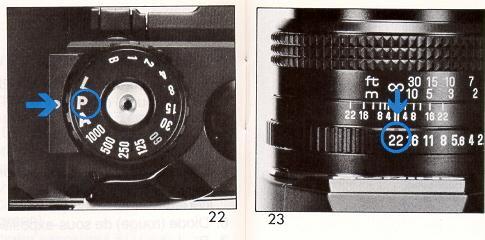
2. Set the lens at its minimum aperture (Fig. 23). This setting is color coded green on your standard 50 mm lens to match the green "P" setting on the Exposure Mode Select Dial. Accessory lenses should also be set at their minimum aperture.
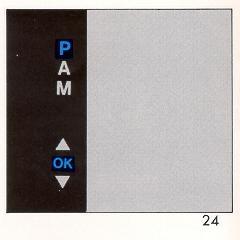
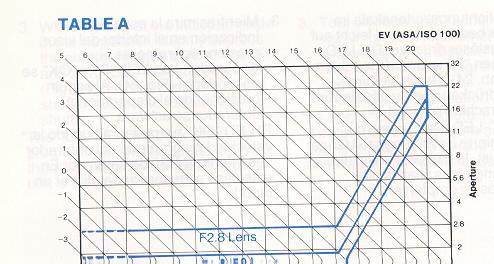
CHINON CP-X programmed AE characteristics are shown in the TABLE A. With a 50
mm F1.4 lens both shutter speeds and aperture vary to obtain correct exposures
as lighting conditions fluctuate above EV 7 (Exposure Value 7): Below EV 7,
only the shutter speed changes.
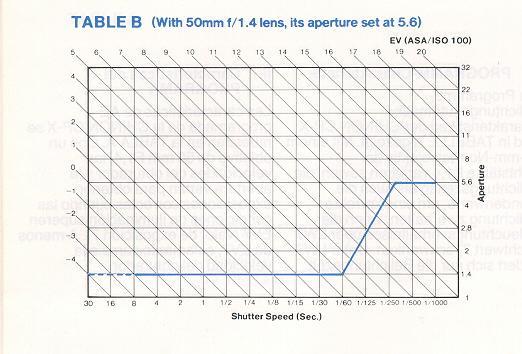
Unlike other program cameras, CHINON CP-X camera accepts any existing "K" mount lens even in the program mode. Generally, you should set the aperture at its minimum setting (largest number on f-stop aperture ring]. Although a perfectly exposed picture will result at any selected aperture setting, the program range is limited by not "stopping down" the lens to the minimum aperture. For example, using the 50 mm V1.4 lens with its f/stop set at 5.6, the camera is controlled by the program characteristics of f/1.4 through f/5.6. Beyond f/5.6, the camera is controlled by the aperture priority automatic exposure mode (See Table B).
APERTURE PRIORITY AE (AUTOMATIC EXPOSURE)
PHOTOGRAPHY
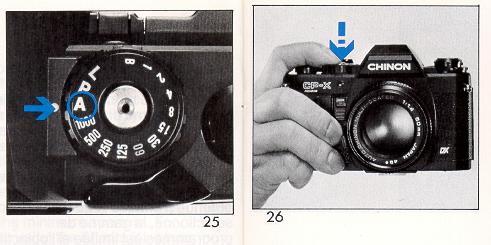
After you have set the Exposure Mode Select Dial to "A" and selected the
desired aperture, the camera will automatically select the stepless shutter
speed from 1 sec. to a fast 1/1000 sec. "A" mode is convenient for taking
pictures at specific aperture settings based on your individual needs.
* OK" LED will blink when the shutter speed is slower than 1/30 sec. Use of a
tripod is then recommended, or you can increase the shutter speed by opening
the lens aperture.
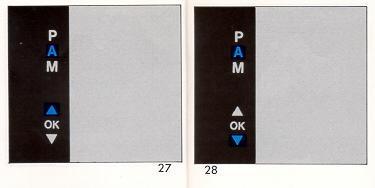
* If the computed shutter speed is even longer than 1 sec. (semi-darkness
condition), the under exposure indicator (a) will appear (Fig. 28). Open the
lens diaphragm by turning the aperture ring or use a film with a higher ISO
number, or use a flash.
MANUAL PHOTOGRAPHY
You can manually control the CHINON CP-X when the camera is set to a
preselected aperture or shutter speed. This program camera is equipped with a
convenient "Power Hold Circuitry" - automatic shutoff after 12 seconds. 1. Set
the required shutter speed on the dial (Fig. 29).
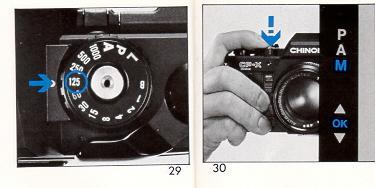
2. Set the required aperture on the lens. Depress the shutter release button
until the meter activates and observe which mark is indicated in the
viewfinder by an LED, so that correct exposure can be obtained (Fig. 30).
There are two methods of selecting the correct exposure (M mode]
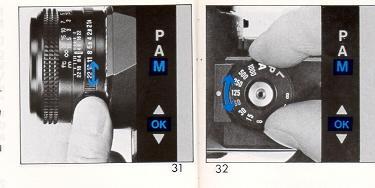
Power-hold circuitry:
When the shutter release button is pressed halfway down and then pressure is
released, the camera circuitry stays on for 12 seconds. This permits
convenient manual exposure metering without risk of accidentally taking a
picture.
SHUTTER RELEASE AND RELEASE LOCK
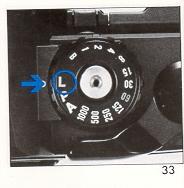
Your CHINON CP-X program camera features a two stage electromagnetic shutter
release with safety lock. When the shutter release button is depressed
halfway, the electronic circuitry starts functioning. When the button is fully
depressed, it will trigger the shutter. Always hold the camera steady and
gently depress the shutter release button to make an exposure. The position
marked "L" on the exposure mode select dial is the shutter release safety lock
position. When this is aligned with the index mark, the batteries are
disconnected from the circuitry and an exposure cannot be made (Fig. 33). This
position is also used when the camera is not to be used for a long time.
UNLOADING EXPOSED FILM
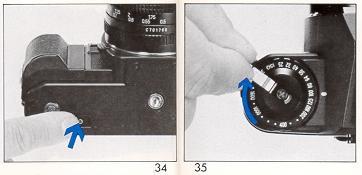
When the film in the camera is fully exposed, the film advance lever will
stop. Do not attempt to force the lever any further but rewind the film and
replace with a new one. Push in the rewind lock release button at the bottom
of the camera (Fig. 34). Unfold the rewind crank of the rewind knob. Turn the
rewind crank clockwise (Fig. 35). You will feel friction as the film is
rewound from the camera, back into the film cartridge. Suddenly, when the film
is rewound completely, the friction decreases and the rewind crank will turn
with ease.
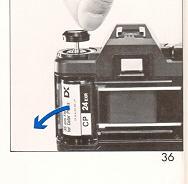
Then pull up on the rewind knob to open the camera back (Fig. 36). When the
camera back is opened, the frame counter will automatically reset to "S". The
rewind lock release button on the bottom of the camera will pop out to the
normal position when the film advance lever is advanced again. Your exposed
film should be processed without delay.
AE LOCK SYSTEM
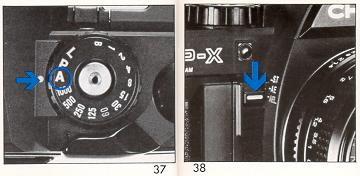
This camera has an AE Lock system. Under normal circumstances your CHINON CP-X
program camera will produce perfectly exposed photographs, due to the
integrated automatic exposure circuitry. However, some lighting conditions
might occur that could mislead the system, such as subjects with a very high
contrast or strongly back-lit scenes. In such cases, the exposure memory
feature should be used.
1. Make sure that the Exposure Mode Select Dial is set to the "A" position (Fig. 37).
2. Press down the Self-timer/AE lock switch to the "AEL" position (Fig. 38).
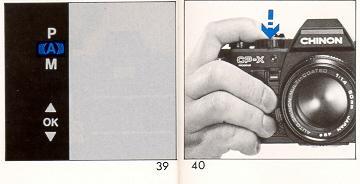
3. Look through the viewfinder and center your subject in the split microprism
center spot, and depress the shutter release button halfway. "A" LED in the
viewfinder will blink (Fig. 39). The exposure will be memorized as long as the
shutter release button is halfway depressed (Fig. 40).
4. Focus and compose the subject in the viewfinder as you desire, then press the shutter release button all the way to take the photograph.
NOTE: Be sure to return the Self-timer/AE lock switch to the normal position (kA) after use.
* When the exposure mode select dial is set to the program mode "P", the exposure will not be memorized.
SELF-TIMER
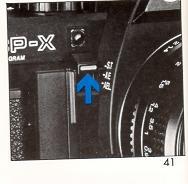
Your CHINON CP-X program camera is equipped with an electronic self timer with
a red LED indicator. The built-in self-timer electronically delays the shutter
release for ten seconds. The camera should be mounted on a firm support during
self-timer operation. To activate the self-timer, place the self-timer switch
to the upper position and depress the shutter release button (Fin. 41). You
will notice the red self-timer LED blinking and two seconds before the shutter
release the flashing frequency will increase giving you or your audience time
to smile. The self-timer may also be utilized for releasing the shutter at low
shutter speeds when a cable release is not available. If you decide not to use
the self-timer, you can cancel it even after it started to operate. Just
return the self-timer switch to the normal position for cancellation.
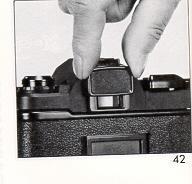
NOTE: When utilizing the self-timer with the exposure mode select dial set at
"P" or the "A", it is recommended to block the viewfinder with an eyepiece
cover or similar item to prevent extraneous light from interfering with the
automatic exposure system of the camera (Fig. 42).
FLASH PHOTOGRAPHY
Your CHINON CP-X program camera is designed with a unique flash system, making
flash photography simple. The CP-X gives a wide range of flash use, such as X
sync at fast 1/100 sec., flash photography at slower speeds is also possible.
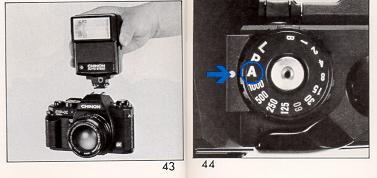 1.
Mount a CHINON dedicated flash to the camera (Fig. 43). Set the f- stop
indicated on the exposure calculator dial of your CHINON flash to the
corresponding aperture ring on the lens. Set the exposure select dial to the
"A" position (Fig. 44).
1.
Mount a CHINON dedicated flash to the camera (Fig. 43). Set the f- stop
indicated on the exposure calculator dial of your CHINON flash to the
corresponding aperture ring on the lens. Set the exposure select dial to the
"A" position (Fig. 44).
2. A few seconds after your CHINON flash is turned to the "ON" position, the flash ready light will illuminate. When the flash has reached adequate power, the camera's shutter speed is automatically set to the 1/100 sec. flash sync speed, and the flash ready LED (red) in the viewfinder will light up.
3. With the exposure mode select dial set at "A", after the picture has been taken and before the flash has recycled, the camera will automatically switch to the automatic exposure mode until the flash has once again recycled. Slow Synchronization (Manual Mode Flash Photography)
If you desire to synchronize at a speed slower then 1/100 sec., set the
desired shutter speed by turning Exposure Mode Select Dial (Fig. 45). The
shutter will be released at the selected speed. Set the aperture as
indicated by the flash unit.
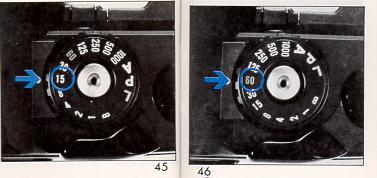
NOTE: When the shutter speed faster than 1/100 sec. is set
with dedicated flash, the shutter speed will be automatically set to 1/100
sec. after the flash is fully charged. Other electronic flash units can be
utilized with your CHINON CP-X program camera. When using non-dedicated
automatic flash units, set the Exposure Mode Select Dial to the "60" position.
This sets the correct shutter speed (1/60 second) on your camera for flash
photography with non-dedicated flash units (Fig. 46).
NOTE: It is advisable to use only CHINON dedicated flash units or units designed specially for use on CHINON cameras.
B (BULB) SETTING
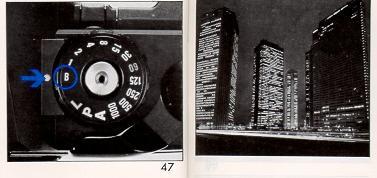
The B setting is used for shooting night scenes or long time exposures. Set
the Exposure Mode Select Dial to the "B" position (Fig. 47). The shutter and
mirror will move to the open (up) position while the Shutter Release Button is
depressed. Use of a cable release and a tripod is recommended for stability to
prevent camera movement during the time exposures.
DEPTH OF FIELD
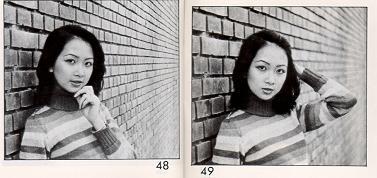
Depth of field designates the nearest and furthest limits of the area that
will be sharp in the picture in front of and beyond the subject. Depth of
field is controlled by f-stop. The larger the lens opening (f/stop), the
shallower is the depth of field. The smaller the lens opening, the greater the
depth of field will become (Fig. 48, 49).
Depth of Field Scale:
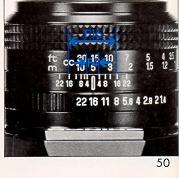
The depth of field scale indicates (after focusing) the approximate area that
will be sharp in the picture. Locate on the depth of field scale the
corresponding pair of f/stop figures. The distance between these two V stop
figures on the focusing ring will be the area of the sharpness in your picture
(Fig. 50).
AUTO WINDER SYSTEM
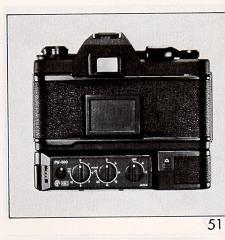
The CHINON CP-X optional Power winder system features the World's First
"Single Power Source System". When equipped with CHINON Power Winders (PW-600,
PW-610), the camera's power source is supplied from the power winder. This
system is extremely convenient when photographing in cold weather. When using
the PW-600 winder it is possible to shoot continuously for a predetermined
amount of frames (up to 24 exposures), at intervals of your choice (up to 30
seconds) (Fig. 51).
NOTE: To attach a CHINON Power Winder to the camera power, the power grip (battery compartment) has to be removed from the camera body. Before attaching the winder, wipe the contact points on both the camera and the winder with a dry cloth.
INFRARED PHOTOGRAPHY
The infrared index mark is a way to correct the focusing point when you use
infrared film with red filters. Since infrared light rays have a longer
wave-length than visible light rays, after focusing normally on the subject,
you have to set that distance against the infrared index mark.
<< If
interested in IR photos, try digital >>>
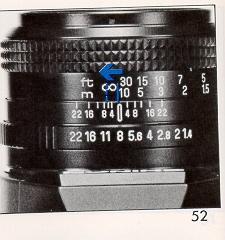
Taking Infrared Photographs
2. Reset the indicated distance on the lens to the infrared index mark (Fig. 52). According to the instructions enclosed with the film, set the f-stop and shutter speed and release the shutter. Infrared light rays are invisible to the eye and the camera's light meter, so refer to the instructions with the film for setting the f-stop number and shutter speed. (The automatic exposure system in your camera can not be used.)
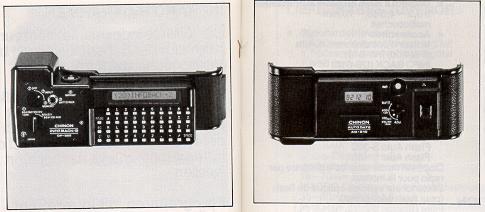
AUTO DATE Quartz Digital Data Imprinting Unit (AD-510)
Accessory data back featuring electronic imprint of year, month, day or hour,
minute directly on your negative or slide. Data automatically resets until
year 2019.
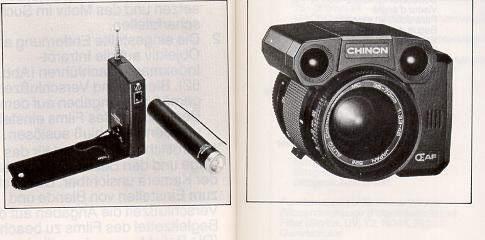
REMOTE CONTROL UNIT
When used with the optional CHINON Remote Control Set and optional power
winder, you can operate the CP-X camera from up to 100 feet away.
AUTO FOCUS LENS 35-70mm F3.3-4.5 AF ZOOM
CHINON Auto-Focus lens focuses the subject via active infrared beam. The
subject is focused at pin-point sharpness even under extremely low or no light
situations and/or low contrast situations. And since the lens have their own
built-in auto focus button' you can use the lens on any "K" mount cameras.
OPTIONAL ACCESSORIES
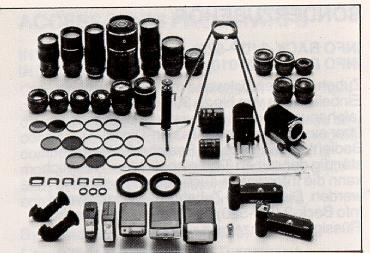
|
× Standard Lens: 50mm f/1.4 multicoated; 50mm f/1.7 multicoated; 50mm f/1.9 multicoated 17mm f/3.5 multicoated 28mm f/2.8 multicoated 35mm f/2.8 multicoated Telephoto lenses 135mm t/2.8 multicoated 300mm f/5.6 multicoated 500mm f/8 reflex type Zoom Lenses 28-70mm f/2.8-4.2 multicoated MACRO 35-80mm f/3.5 - 4.8 multicoated MACRO 35-105mm f/3.5~4.5 multicoated MACRO 75-200mm W~4.8 multicoated MACRO 75-300mm f/5.6 multicoated MACRO × Auto Focus Lens 35-70mm f/3.3 - 4.5 multicoated |
INFO BACK (DB-O1O) AUTO DATE (AD-510) Accessory Power Winder (PW-600, PW-610) |
CARE OF THE CAMERA
Your CHINON CP-X program single lens reflex camera is a precision instrument.
Used with care, it will provide years of trouble free service. Protect your
camera from dirt, dampness, and excessive heat. Avoid touching the lens. To
clean the lens, wipe it gently with a soft lintless cloth or lens tissues. Do
not use eyeglass tissues as they might damage the lens coating.